
This page is among our best articles.
The Question of Correlation between Photons in Coherent Light Rays
The Question of Correlation between Photons in Coherent Light Rays is the title of (at least) three Nature papers, the most important of which is by Edward Purcell, establishing the foundation for quantum optics. The two others are also discussed below. Note that in all cases, "coherent light" refers to monochromatic, as this was, precisely, before Glauber's understanding that coherence refers to such an absence of correlations.
The Question of Correlation between Photons in Coherent Light Rays. E. M. Purcell in Nature 178:1449 (1956).
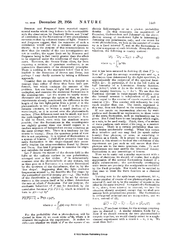
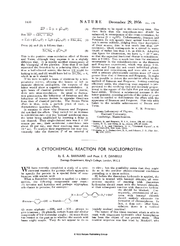
This historical piece is a pillar of quantum optics, from a prominent physicist of the time (Hanbury Brown was even more, at this time, a secondary figure). It shows that the HBT effect is, not only correct, but in fact, in the words of Purcell:
the Brown—Twiss effect, far from requiring a revision of quantum mechanics, is an instructive illustration of its elementary principles.
Although Purcell seems to go deeper into the theoretical understanding and, in particular, to extend it to fermions (predicting anticorrelations), he demonstrates great humility and elegance in his entering (and settling) the debate:
There is nothing in the argument below that is not implicit in the discussion of Brown and Twiss, but perhaps I may clarify matters by taking a different approach.
Despite such grace, and several attempts to give tribute to everybody, one may, possibly, detect a hint of sarcasm against the losing party (for instance Purcell's paper is exactly the same as that of Brannen and Ferguson, which is also the case from Hanbury Brown & Twiss but they had more rationale for biting back).
Purcell correctly attributes the effect to a bosonic bunching:

and gives an insightful phenomenological description:
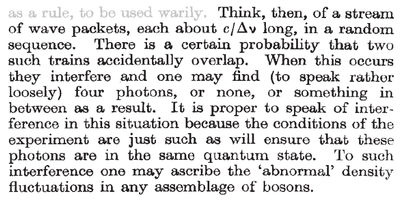
This is his comments for fermions:

Purcell cites four papers: those fueling the debate which it arbitrates, between Hanbury Brown and Twiss[1] and Brannen and Ferguson's rebuttal of it,[2], as well as a book (“Threshold Signals”) to justify a Fourier-type of relationship between the spectrum and intensity correlations, which is probably obsolete now and that it would be interesting to contrast to Glauber's later works on photodetection. The last paper[3] is mentioned in passing as "interesting" and might indeed be another (and independent) precursor of the effect itself. This work by Purcell thus calls for Historians of Science to further dig into how much of Quantum Optics was already settled down by Purcell on this 29 December (1956).
He also explains why Brannen and Ferguson did not see the effect while Hanbury Brown and Twiss could, noting that the latter did not work at the photon level and although ««it ought to be possible to detect the correlation effect»» in this way, he estimates that
counting periods of the order of years would be needed to demonstrate the effect with the apparatus of Brannen and Ferguson.
And concludes
This only adds lustre to the notable achievement of Brown and Twiss.
The Question of Correlation between Photons in Coherent Light Rays. R. Hanbury Brown and R. Q. Twiss in Nature 178:1447 (1956).
Hanbury Brown and Twiss did not need Purcell's help in refuting the arguments raised against them. They focus their entire reply on showing that the measurements mentioned (those of Brannen & Ferguson below but also from Janossy et al.) do not contradict their own results but fall in a regime of dim signal (at the single-photon level) which does not allow them to resolve the effect, for which thousands of year (for Brannen & Ferguson) and a whooping $10^{11}$ years (for Janossy) of measurements would be needed to emerge a signal from the noise. In contrast, the result was obtained in 10 minutes by HBT (compared to the 5 estimated):

The main reason for departure is that they use linear multipliers (as opposed to photo-detectors as in the competing cases), which is in line with Hanbury Brown's conception of the effect, which started with microwaves and not rooted in a photon picture. They do indeed mention that they are developing a quantum theory, but do not enter into further details.
Purcell's paper reverses the balance by focusing on the quantum aspects and devoting only a small fraction to account for the negative results.
This work thus shows that Hanbury Brown and Twiss were more than able to stand by their results on their own, however, the (simultaneous and independent) input from Purcell was certainly decisive in convincing the quantum community at large.
The Question of Correlation between Photons in Coherent Light Rays. E. Brannen and H. I. S. Ferguson in Nature 178:481 (1956).
This is the first paper (with that title), dated September (1956), which embodies the rebuttal to Hanbury Brown & Twiss' claims.

They performed experiments at the single-photon level, and had much prior experience in observing photon correlations, from cascaded transitions. Therefore it is not surprising that the claim, from "outsiders", of photon correlations without an underlying connection between the particles, would be received with more than suspicion. Indeed this is their rationale that they have something to compare to, as opposed to HBT who may, therefore, have suffered from artifacts. They suggest fluctuations from the source, since they still have to contend with the fact that in the microwave regime, the effect is supposedly working:
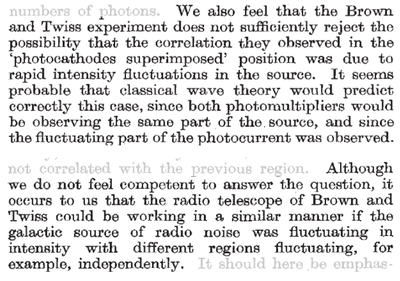
Using a setup that measures positive correlations, they fed their "coherent" input to observe, indeed, no correlations:
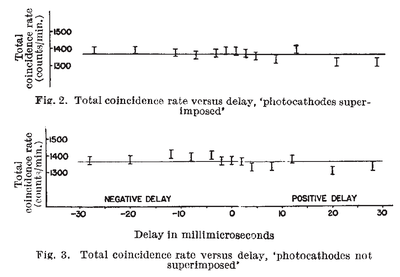
The most embarrassing part of their text, picked up by both Purcell and HBT, is a note added in the proof:

References
- ↑ Correlation between Photons in two Coherent Beams of Light. R. Hanbury Brown and R. Q. Twiss in Nature 177:27 (1956).
- ↑ The Question of Correlation between Photons in Coherent Light Rays. E. Brannen and H. I. S. Ferguson in Nature 178:481 (1956).
- ↑ Photoelectric Mixing of Incoherent Light. A. T. Forrester, R. A. Gudmundsen and P. O. Johnson in Phys. Rev. 99:1691 (1955).